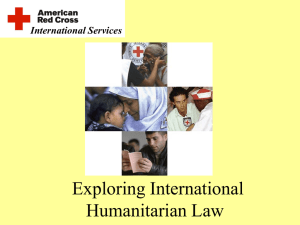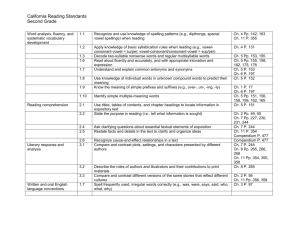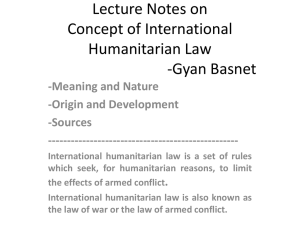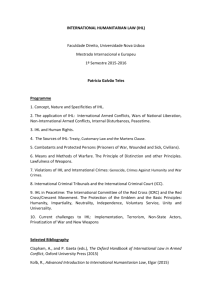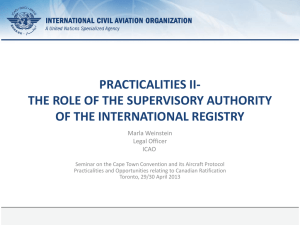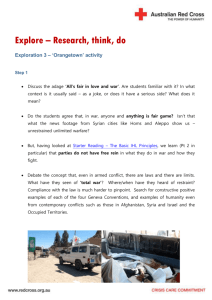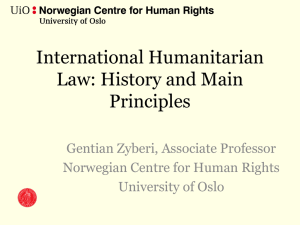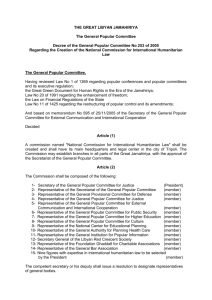Reading assigment
advertisement
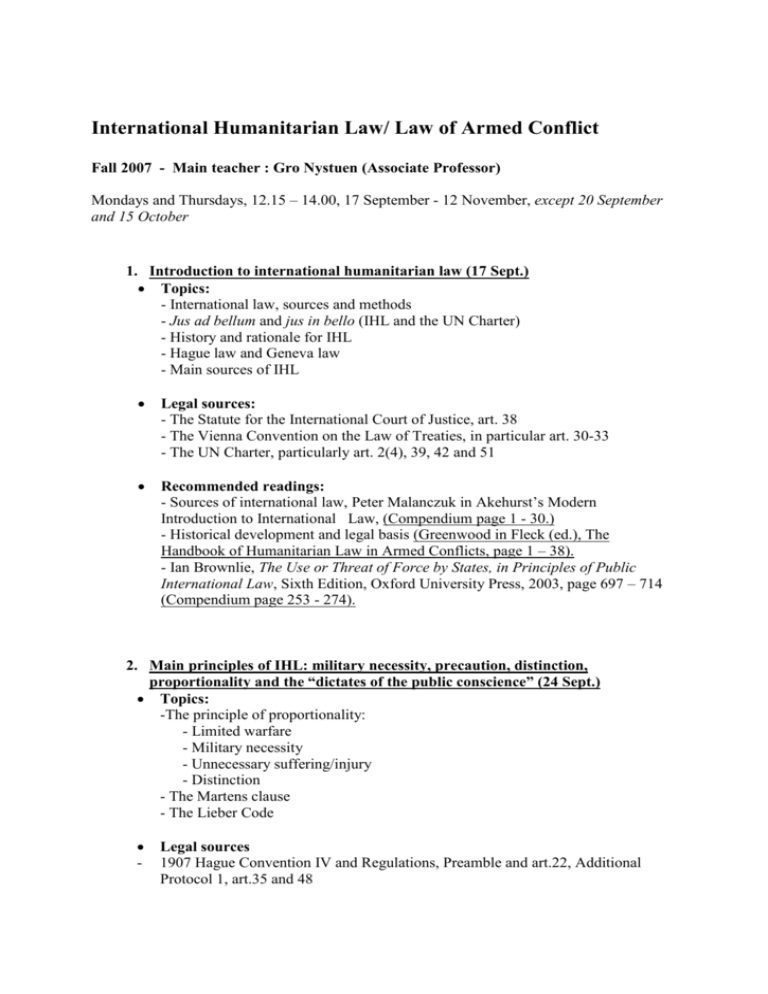
International Humanitarian Law/ Law of Armed Conflict Fall 2007 - Main teacher : Gro Nystuen (Associate Professor) Mondays and Thursdays, 12.15 – 14.00, 17 September - 12 November, except 20 September and 15 October 1. Introduction to international humanitarian law (17 Sept.) Topics: - International law, sources and methods - Jus ad bellum and jus in bello (IHL and the UN Charter) - History and rationale for IHL - Hague law and Geneva law - Main sources of IHL Legal sources: - The Statute for the International Court of Justice, art. 38 - The Vienna Convention on the Law of Treaties, in particular art. 30-33 - The UN Charter, particularly art. 2(4), 39, 42 and 51 Recommended readings: - Sources of international law, Peter Malanczuk in Akehurst’s Modern Introduction to International Law, (Compendium page 1 - 30.) - Historical development and legal basis (Greenwood in Fleck (ed.), The Handbook of Humanitarian Law in Armed Conflicts, page 1 – 38). - Ian Brownlie, The Use or Threat of Force by States, in Principles of Public International Law, Sixth Edition, Oxford University Press, 2003, page 697 – 714 (Compendium page 253 - 274). 2. Main principles of IHL: military necessity, precaution, distinction, proportionality and the “dictates of the public conscience” (24 Sept.) Topics: -The principle of proportionality: - Limited warfare - Military necessity - Unnecessary suffering/injury - Distinction - The Martens clause - The Lieber Code - Legal sources 1907 Hague Convention IV and Regulations, Preamble and art.22, Additional Protocol 1, art.35 and 48 - Recommended readings: The Martens Clause: Half a Loaf or Simply Pie in the Sky? Cassese in EJIL 2000, vol 11, no.1, p 187 – 216, (Compendium page 131 - 160). DRAPER, G.I.A.D., «Military Necessity and Humanitarian Imperatives», in Revue de Droit Pénal Militaire et de Droit de la Guerre, vol. XII (2), pp. 129-151, (Compendium page 161 - 178). 3. Applicability – scope: personal scope of application and material scope of application (qualification of conflicts) (27 Sept.) Topics - Who are protected by IHL - Where does IHL apply - When does IHL apply (Qualifications of conflicts) -International armed conflicts - Non-international armed conflicts - Internal disturbances, tensions etc. - Parties to the conflict - Termination of the conflict Legal sources - The Geneva Conventions, and in particular their Common Article 2 - Additional Protocol 1 and 2 to the Geneva Conventions - Common Article 3 of the Geneva Conventions - Recommended readings Christopher Greenwood, Scope of Application of Humanitarian Law, (Fleck (ed.) page 39 – 62) 4. Group work/Role play (involving active use of the relevant sources of law) (1 Oct.) (Material will be distributed) 5. Methods in armed conflict – legal framework (4 Oct.) Topics - The terms “military objective” and “civilian object” - Combatant status - Indiscriminate attacks - Targeting - Ruses of war and perfidy - Reprisals Legal sources - Additional Protocol 1, art. 43, 49, 50, 51, 52, 53, 54, 55, 56, 57 - Additional Protocol 1, art. 37 - Vienna Convention on the Law on Treaties art. 60 (5) Recommended readings -Stefan Oeter, Methods of Combat, (Fleck (ed.) Page 153 – 207) 6. Means in armed conflict – legal framework (8 Oct.) Topics -Early regulations of weapons (maux superfluous) -Weapons of Mass Destruction - Environmental modification as warfare - Convention on Certain Conventional Weapons - Anti personnel landmines - “Non-lethal” weapons - International process on cluster weapons -Technological innovation and its influence on warfare Legal sources: - Additional Protocol 1, art.35 (2) - The Petersburg Declaration (1868) - The Non Proliferation Treaty (1968) - Biological Weapons Convention (1972) - ENMOD Convention (1977) - The Convention on Certain Conventional Weapons with protocols (1980) - Chemical Weapons Convention with protocols (1993) - The Mine Ban Convention (1997) Recommended readings - Stefan Oeter, General Rules and Means of Combat, (Fleck (ed.) page 111 – 152) - ICRC Study on customary law, rule 70-86, (Compendium page 181 - 296) 7. Protection of Prisoners Of War (POWs) and civilians (11 Oct.) Topics - Status as POW - Conditions of internment - Termination, repatriation - Protection of the civilian population in armed conflict - Civil defence - Occupied territory - Occupation – rights and duties, jurisdiction, etc. - Aliens in the territory of a party to the conflict - Internment of civilians Legal sources - POW’s - Hague Regulations 1907 (art. 4-20) - Geneva Convention III - Additional Protocol 1, art. 43-47 and 75 - Civilians - Hague Regulations 1907 (art. 42 – 56) - Geneva Convention IV - Additional protocol I Recommended readings - Horst Fischer, Protection of Prisoners of War, (Fleck (ed.) page 321 – 363) - Hans-Peter Gasser, Protection of the Civilian Population, (Fleck (ed.) page 209288) - ICRC Study on Customary IHL, Volume I, page 384-396 rules 106-108, (Compendium page 241 - 252). - Opinion by the Venice Commission on “The possible need for further development of the Geneva Conventions”, 245/2003, (Compendium page 45 – 71). 8. Grave breaches – individual criminal responsibility (ICC) (18 Oct.) Topics - International mechanisms for prosecution since WWII - Nuremberg and Tokyo - ICTY and ICTR - ICC - Crimes under international law - Genocide - Crimes against humanity - War crimes - (The crime of aggression) Legal sources - The Charter of the International Military Tribunal (1945) - The Statutes of the ICTY and the ICTR (1993 and 1994) - The ICC Statute (1997) Recommended readings - Antonio Cassese, Chapter 2: Fundamentals of International Criminal Law, in International Criminal Law, Oxford University Press, 2003, page 15 – 41, (Compendium page 131 - 160). - Antonio Cassese, Chapter 12: International Crimes, in International Law, Oxford University Press, 2001, page 246 -259, (Compendium page 275 - 290). 9. Asymmetrical warfare and “direct participation in hostilities” (22 Oct.) Topics - The characteristics and problems of asymmetrical warfare: from the 1907 Hague Conference to contemporary conflicts - When do civilians loose their protection because of “direct participation in hostilities” - When can targeted killings outside of combat situations be justified Legal Sources - AP I, art. 51 (3) Recommended readings - Knut Ibsen, Combatants and Non-Combatants, in (Fleck (ed.), page 65 – 97) 10. a) Special protection of cultural property and environment (25 Oct.) b)National implementation of IHL (25 Oct.) Topics (a): - The legal framework for the Protection of Cultural Property in an armed conflict - The legal framework for the protection of the environment in an armed conflict Legal sources (a): 1954 Hague Convention for the Protection of Cultural Property in Armed Conflict Protocol 1 of 1954 concerning cultural property in situations of occupation Additional Porotocol 1 to the 1949 Geneva Conventions, in particular Article 53 Article 8 of the Statute of Rome (ICC) 1999 Second Protocol to the 1954 Convention Customary International Law Recommended readings (a): - Karl Josef Partsch, Protection of Cultural Property, (Fleck (ed.) Page 382 – 404). - - (30-09-1999 International Review of the Red Cross No. 835, p. 593-620 by JeanMarie Henckaerts. New rules for the protection of cultural property in armed conflict (Not in Compendium – can be found on internet) 30-09-1999 International Review of the Red Cross No. 835, p. 621-635 by Jan Hladík. The 1954 Hague Convention for the Protection of Cultural Property in the Event of Armed Conflict and the notion of military necessity)(Not in Compendium – can be found on internet) - - - Topics (b): National implementation - National criminal law/military law - Military manuals and instructions - Rules of Engagement - Dissemination - ICRC - International Fact Finding Commission - Deterrent measures Universal jurisdiction Legal Sources (b): Geneva Conventions Common Article 1, Article 49 and 50 of Geneva Convention I (likewise art. 50 and 51 of GC II, Art.129 and 130 of GC III, Art. 146 and 147 of GC IV), Article 85 and 86 (2) of Additional Protocol I Recommended readings (b): - Rüdiger Wolfrum, Enforcement of International Humanitarian Law, (Fleck (ed.), page 517 – 549.) 11. Group work/Role play: The heavy water sabotage actions in Telemark between 1942 and 1944 (29 Oct.) (Material will be distributed) 12. The relationship between international humanitarian law and international human rights law (1 Nov.) Topics: - The main content of IHL and HRL - The scope of application for IHL and HRL (protection for whom and in which situations) - Derogation from human rights in emergencies - The “gap” between IHL and HRL / complementarity - Legal sources: Human rights conventions (in particular ECHR, ICCPR) Article 15 of ECHR and article 4 of ICCPR The Geneva Conventions and Additional Protocols Common article 3 of the Geneva Conventions, and art. 75 of Additional Protocol 1 - Recommended readings: International Humanitarian Law and Human Rights Law, Louise Doswald Beck and Sylvin Vite, International review of the Red Cross, 1993, (Compendium page 103 - 130). General Comment No 29, article 4: Derogations during a State of Emergency, HRI/GEN/1/Rev.6, (Compendium page 31 - 42). - 13. Armed conflicts and the “war against terror” (5 Nov.) - Topics Asymmetrical warfare IHL and terrorist acts – what regimes may be applicable? Security detention of unprivileged combatants Human rights and “the war on terror” Situations below the threshold of IHL Legal sources The UN Charter Security Council Resolution 1373 (2001) Recommended readings - Adam Roberts, The Law of War in the War on Terror, in Terrorism and the Military – International Legal Implications, Wybo P.Heere (ed.), T.M.C.Asser Press, The Hague 2003, page 65-92, (Compendium page 73- -102). 14. Peace Support Operations: Which rules apply? (8 Nov.) Topics - International Peace Support Operations – (peace enforcement and peacekeeping) - Applicable law and the lex specialis principle - Duties of an occupying force - Occupation and peace building - Role of actors not directly involved (governments, organisations, the UN) - Legal aspects of peace support and peace keeping operations - What constitutes humanitarian intervention? - Neutrality and protection of humanitarian and security personnel - United Nations Forces and IHL Legal Sources - The UN Charter - The UN Convention on the safety of UN and associated personnel (1994) - 1907 Hague Convention IV and Regulations - Fourth Geneva Convention Recommended readings - The UN Secretary General’s Bulletin on UN peace forces (United Nations, Secretary-General's Bulletin, ST/SGB/1999/13, 6 August 1999) - Report of the panel on UN Peace Operations (Brahimi Report) www.un.org/peace/reports/peace_operations/ 15. Group work/exam preparation (12 Nov.)
